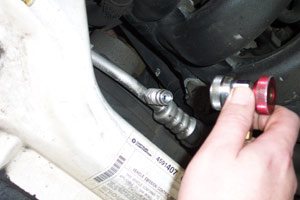 MAJOR COMPONENTS & FUNCTIONS
MAJOR COMPONENTS & FUNCTIONS
*A/C Compressor — A belt-driven pump that generates pressure to circulate the refrigerant inside the A/C system. Many compressors use multiple pistons to pump the refrigerant. Some compressors are “variable displacement” and change the stroke of the pistons according to the cooling load. Some compressors use a scroll design with flexible metal bands instead of pistons.
*Compressor Clutch — A magnetic clutch is used to engage and disengage the compressor. The clutch is energized through a relay and controlled by the HVAC module. Refrigerant leaks around the compressor shaft seal can occur, causing a loss of refrigerant and compressor lubricant. This may lead to compressor failure.
*Condenser — A heat exchanger located in front of the radiator. On some newer vehicles, it is part of the radiator assembly. The condenser receives high-pressure refrigerant gas from the compressor and cools it so the gas will condense into a liquid. Because of its location, it is vulnerable to road hazards and collision damage. Leaks will result in a loss of refrigerant and cooling. The condenser can also be contaminated internally by sludge, or by debris from a compressor failure. The contaminants can be difficult to flush out, so replacing the condenser may be necessary. Replacement condensers must have the same or higher cooling capacity as original for proper cooling performance.
*Evaporator — A heat exchanger located inside the HVAC unit in the passenger compartment that allows refrigerant vapor to cool incoming air. Leaks due to internal corrosion can cause loss of refrigerant. Condensation on the evaporator can cause corrosion and odors. Replacing this component is very difficult and expensive because of its buried location.
*Orifice tube or expansion valve — A control device in the A/C refrigeration circuit that meters the amount of refrigerant entering the evaporator. One of these devices will be located at or near the entrance to the evaporator. If clogged or defective, it will block the flow of refrigerant and cause a loss of cooling. It can also block the flow of compressor oil that circulates with the refrigerant, which may cause the compressor to fail. Replacing an OEM fixed orifice tube with an aftermarket “variable” orifice tube can improve low rpm cooling performance.
*Accumulator or receiver drier — Serves as a reservoir and filter for refrigerant. Inside is a bag of “desiccant” crystals that absorb moisture. This device should be replaced when changing a compressor.
*Refrigerant hoses — Used to connect compressor, condenser and evaporator so refrigerant can travel in a loop. The suction hose is located between evaporator and condenser. The high-pressure hose is located between compressor and condenser. Newer vehicles with R-134a A/C systems require “barrier” (nylon lined) hoses to prevent loss of refrigerant.
*Refrigerant — Pressurized gas inside A/C system that cools air and carries away heat. Since 1995, all vehicles require R-134a, which contains no chlorine that can harm the ozone layer. Older vehicles used R-12, which is no longer made in this country. Most older R-12 A/C systems can be retrofitted (upgraded) to R-134a, but the two refrigerants should not be intermixed.
*Heater core — A heat exchanger that uses engine coolant to heat incoming air. Airflow through the core is controlled by doors inside the HVAC assembly. Leaks caused by internal corrosion can result in coolant loss.
*Heater control valve — Regulates flow of coolant through heater core. May be located in one of the heater hoses that connects the heater core to the engine.
*Blower Motor — Drives the fan that is used for heat and A/C. Motor is powered through a relay that routes power through a “resistor block” or module to vary blower speed. If the blower does not work, the control switch, relay, wiring or blower motor itself may be defective.
RELATED ITEMS
*Compressor oil — Mineral oil required for older R-12 applications, while PAG oil or POE oil is required for newer R-134a systems (follow manufacturer’s recommendations because PAG oils come in several different viscosities).
*Seals and o-rings — Used to seal hose and tubing connections. These should be replaced if leaking, or when retrofitting an older R-12 system to R-134a.
*A/C leak detection dye — Ultraviolet dye that is added to the refrigerant to reveal leaks (especially hard-to-find leaks). Some refrigerant comes with the dye already added.
*A/C system sealer -Additives for sealing A/C refrigerant leaks. Some sealers contain additives that cause worn/hard seals to swell. Other types react chemically in the presence of moisture to plug pinholes in metal components such as evaporators and condensers.
INSTALLING HVAC SYSTEM PARTS
Replacing any component in the refrigeration circuit requires evacuating the old refrigerant from the A/C system (if there is any left to recover), and recycling it.
If a compressor has failed, the condenser and hoses should be flushed (or replaced) to remove debris and contaminants. A new accumulator or receiver drier, and orifice tube should also be installed.
After the parts have been installed, the A/C must be evacuated with a special vacuum pump to remove all the air and moisture. They system can then be recharged with the specified amount of refrigerant and compressor oil.











